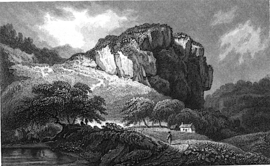| Wicklow Gold Rush | |
|---|---|
 The Wicklow Gold Mines, an engraving by Samuel Rawle appearing in 'Landscape Illustrations Of Moore's Irish Melodies', 1835 | |
| Centre | Goldmines River[1] (specifically in the vicinity of the bridge at Ballinagore),[2] near Woodenbridge, County Wicklow, Ireland |
| Duration | 15 September 1795–15 October 1795 |
| Discovery | 15 September 1795, northern slopes of Croghan Kinsella mountain |
| Discoverers | A group of workers felling timber on the estate of Lord Carysfort |
| Announcement of find | The 16-19 September 1795 edition of Finn's Leinster Journal, and wider exposure in a letter printed in The Freeman's Journal of 29 September[2] |
| Prospectors | Over 4,000 people onsite by 11 October 1795[2] |
| Extraction | Between 1795 and 1830 an estimated 7-9,000 ounces of gold extracted from the Goldmines River[3] |
The Wicklow gold rush, or the Avoca gold rush (1795–),[4] was a gold rush that began on 15 September 1795, following the discovery of gold by a group of workers felling timber on the estate of Lord Carysfort on the northern slopes of Croghan Kinsella mountain, County Wicklow, Ireland.[5][6][7]
- ^ "Abhainn an Mhianaigh Óir / Goldmines River". logainm.ie. Placenames Database of Ireland. Retrieved 2 July 2024.
- ^ a b c McArdle 2011, p. 15.
- ^ Cite error: The named reference
BFwas invoked but never defined (see the help page). - ^ "A brief history of the gold hidden around Ireland". TheJournal.ie. TheJournal.ie. 9 September 2013. Retrieved 2 July 2024.
- ^ McArdle 2011, p. 10.
- ^ King, Anthony (21 March 2013). "The Wicklow gold rush". The Irish Times. Retrieved 2 July 2024.
- ^ Vines, Gail (24 January 2007). "Histories: The hunt for the Wicklow gold". New Scientist. Retrieved 2 July 2024.
© MMXXIII Rich X Search. We shall prevail. All rights reserved. Rich X Search
